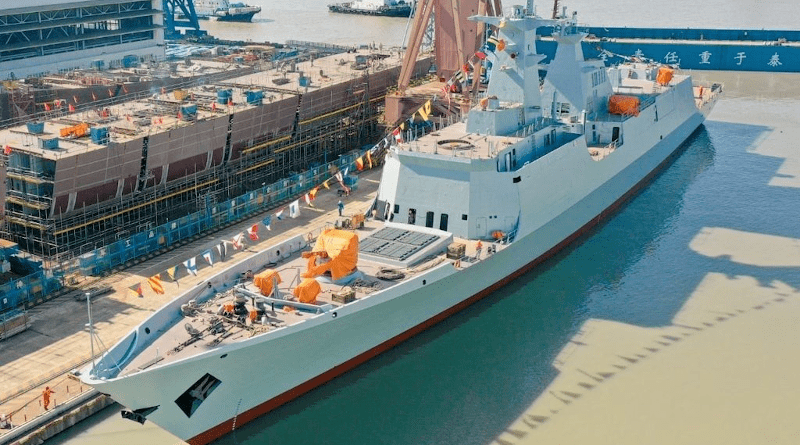China’s ‘Economic Silk Noose’: Indian Ocean – Analysis
By Patial RC
China delivered its largest and most advanced warship Type 054A/P frigate named the PNS Tughril to Pakistan as it seeks to beef up the navy of its all-weather ally in the Arabian Sea and the Indian Ocean. The frigate is the largest and most advanced warship ever exported by China.
China encircled India through the so-called earlier strategy of’String of Pearls’ by heavily investing in ports, infrastructure and defence exports to India’s immediate neighbours. In the process China made grounds for future bases in the garb of economic development. Now China has further cemented their strategy with the Belt and Road Initiative (BRI) capabilities and President Xi Jingping continues pushing his ‘Silk Road Economic Belt’ initiative across the world. China has leapfrogged over land and sea to strangulate India’s environment of its strategic sphere of influence. China’s present political, economic, military and cultural scenario reveals that its grand design and mission would be one of expansion of its power, influence and dominance. General Rawat; “Aggressive posturing will remain a cornerstone of China’s expansionist policy, which we have to be wary about.”
The Chinese maritime policy of aggression is expanding its presence across the South China Sea, the Indian Ocean, from the Straits of Malacca to the shores of East Africa and beyond towards Europe. China will have bases in Myanmar (port of Kyaukphyu) in the Bay of Bengal, in Sri Lanka (Hambantota port) and in Pakistan’s Gwadar port. China’s reach has now reached up to Israel’s Haifa port terminal in the Mediterranean Sea as well.
China besides the advanced naval ships has a large number of joint defence ventures with Pakistan, its closest strategic friend to include the building of JF-17 fighter aircraft. Military cooperation in recent years has focused more on the navy as China gradually stepped up its naval presence in the Indian Ocean and the Arabian Sea to encircle India in recent years.
Globalization is not only resulting in greater world economic integration and interdependence, but also in the rise of China’s new economic power and the fast growing economic influence in Asia, Central Asian Republics, Europe, Africa and South America. The Quads have emerged as a force to resist Chinese maritime and economic aggression. Despite the tough talk to counter China, its trade with the US and India is increasing at a fast pace. Indian trade has grown by almost 50 per cent during the year 2021. Wonder how far each Quad member will go to reduce the economic trade interdependency on China, which is very large for all.
ASEAN countries physically and ethnically are closer to China. China through its BRI. China is also further cementing its relation with India’s immediate neighbours like Myanmar, Bangladesh and Sri Lanka. China is also pushing for the Bangladesh-China-India-Myanmar (BCIM) Economic Corridor being introduced as the ‘Southern Silk Road.’ China has been steadily pushing rail connectivity to South East Asian neighbours. China also aims to promote and push the ‘Silk Road Economic Belt’ in Central Asia, the Economic Corridor from Xinjiang to Gwadar in Pakistan. Maritime Silk Road with South East Asia and a Southern Silk Road with South Asia.
China’s economic growth poses serious security concerns for India. Trade imbalance with China is widening. China is making new inroads into the Indian neighbourhood and the Indian Ocean nations through economic aid and infrastructural development. Though China emphasizes that its cooperation is purely economic in nature, its growing influence could eventually lead to development of closer strategic collaboration as well, undermining India’s own regional influence. China has gradually enhanced its foothold in the Indian peninsula, expanding its footprint in South East Asia and Central Asia thereby strangulating India by its Silk Economic Belt.
China is likely to remain the biggest challenge for India and the world at large. China’s New Border Law “stipulates that the sovereignty and territorial integrity of the People’s Republic of China are sacred and inviolable”. Passing such a law during the continuing stalemate in negotiations with India sends a clear signal that it is in no mood to end the 18-month-long crisis early along the LAC and vacate the occupied territories.
President Xi Jinping while speaking at an event on the 110th anniversary of the revolution that overthrew China’s last imperial dynasty in 1911 said “No one should underestimate the Chinese people’s staunch determination, firm will, and strong ability to defend national sovereignty and territorial integrity.” A veiled warning to the world; “Do Not try and mess with us- China.” And Xi is aspiring to be a Life Time President which is almost certain.
India’s Defence Secretary Ajay Kumar has recently stated: “We cannot ignore what China has aimed for itself. It wants to be merely a regional power no more, but aims to be a world-class military power by 2049. It has increased capabilities in land, space and cyber domains in the last decade, especially in electro-magnetic spectrum and drones, among other things.”
China has adopted a long-term policy of ‘strategic containment’ of India. The earlier ‘String of Pearls’ around the Indian peninsula is being converted into a garland of thorns through the Chinese Belt and Road Initiative of their revival of the Old Silk Route, Maritime Silk Road and other Silky catchy initiatives. India needs to be wary of China’s expanding Economic and territorial designs which are detrimental to India’s long term interests. The best way for India is to strengthen itself through greater cooperation on trade, security, geopolitical issues and be wary about China’s expansionist designs.


An excellent analysis of China’s comprehensive strategy of domination.
As suggested, India needs to concentrate on further improving it’s economic status do that it can create a deterrent force as well as acquire greater diplomatic clout.
Congratulations